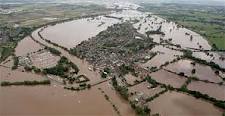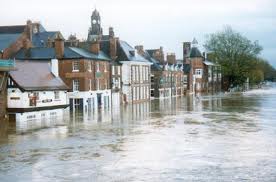 New flood risk maps have been produced by the Environment Agency that, for the first time, also include areas at risk of flooding from surface water in addition to the risk from rivers and the sea. According to The Independent, new mapping techniques used by the EA have reduced the number of homes shown at risk of surface water flooding – when the drainage system cannot cope with extreme heavy rainfall – by 800,000 to 3 million with a further 2.4 million properties are at risk of flooding from rivers and/or the sea.
New flood risk maps have been produced by the Environment Agency that, for the first time, also include areas at risk of flooding from surface water in addition to the risk from rivers and the sea. According to The Independent, new mapping techniques used by the EA have reduced the number of homes shown at risk of surface water flooding – when the drainage system cannot cope with extreme heavy rainfall – by 800,000 to 3 million with a further 2.4 million properties are at risk of flooding from rivers and/or the sea.
The new EA flood risk maps will give insurance companies more information to set premiums and could alter the risk profile of homes now shown as at risk of flooding, with some homeowners seeing their premiums increase.
For homeowners that search for the best deals using comparison websites, the average annual premium is £130 according to the AA. However, those that live in areas deemed at risk of flooding pay huge premiums and have excesses that can be thousands of pounds, with insurance companies setting premiums to fully reflect the risk of flooding.
 In the past, homeowners in high-risk areas have been subsidised to some extent by those living in regions with a low risk of flooding. However, this has now become unsustainable, with the increasing frequency, number and cost of claims arising from damage caused by flooding since 2007. Some policyholder’s premiums have risen substantially, by as much as 35%, after a revised flood risk assessment by their insurers. Many homes that had been flooded in the past have become virtually uninsurable.
In the past, homeowners in high-risk areas have been subsidised to some extent by those living in regions with a low risk of flooding. However, this has now become unsustainable, with the increasing frequency, number and cost of claims arising from damage caused by flooding since 2007. Some policyholder’s premiums have risen substantially, by as much as 35%, after a revised flood risk assessment by their insurers. Many homes that had been flooded in the past have become virtually uninsurable.
“Flood Re” scheme announced: After June 2013, some homeowners were at risk of having their cover withdrawn because of the flood risk when the insurance industry agreement with the government on universal home insurance irrespective of any flood risk came to an end. However a ‘Memorandum of Understanding’ has been agreed in principle between UK insurers and the Government. The plan is to develop a not-for-profit flood fund – commonly referred to as “Flood Re” – ‘Re’ standing for reinsurance – that would ensure flood insurance remains affordable and available on all homes that have a high risk of flooding. Although the detail of the scheme has yet to be worked through and formally agreed, it is anticipated that the remaining issues could be resolved to allow the scheme to start in the summer of 2015.
The new scheme will provide a fund that will enable people with homes at high flood risk, who might otherwise struggle to get affordable flood insurance to get cover. With the help from the fund, insurers will be able to continue to insure high flood risk homes with the cost of cover of the flood risk part of the household premium capped. The cap will be based on Council Tax bands, starting at no more than £210 per annum in Bands A and B, rising to £540 a year in Band G. The capped premiums will go into the fund to help pay flood claims. So if you are at flood risk you know that the cost of your flood insurance will be limited.
‘Flood Re’ is designed to provide support to those who need it most and will cover homes. Around 130,000 homes in England in the highest Council Tax band H, and equivalent properties in Scotland, Wales and Northern Ireland will not be covered by the scheme. Those buying a new home should be aware that all homes built after 1 January 2009 will not be covered,. This is to avoid any promotion or subsidy for foolish building in areas prone to flooding. It is now even more essential to check that new developments are not included on the EA flood risk maps.
The new scheme is to be paid for by every homeowner, with home insurance subject to a new levy, that will increase all home insurance premiums, on average, £10.50 a year.
This will become a stealth tax by any other name. If the government is unwilling or unable to fund building new flood defences, why should every household be forced to pay a new levy to subsidise insurance companies and bail out people that foolishly bought a home at risk of flooding. Why not do away with fire services and charge homeowners a new levy to cover those households that lose everything in a fire? It is just as daft!
Insurance is supposed to reflect risk. The more risk, the higher the premium. Homeowners living in low crime areas do not pay a levy to enable those who live in areas with high burglary rates to get cheaper contents insurance. A mature low-risk driver would not expect to pay a levy to cover the extra risk of an accident by a young high-risk driver, anymore than a mini owner would pay a levy for the extra risk of a claim from a high performance sports car owner. Non-smokers don’t pay a levy to reduce the premiums for life insurance or critical illness policies for a 20 a day smoker!
To be flooded once is unfortunate, twice is careless! If people buy homes in areas with a high risk of flooding, or have not had the sense to flood-proof their homes following first-time flooding, then why should everyone else be expected to subsidise the additional risk of insuring their home and bail them out? House builders should also be required to pay for the cost of flood damage claims to new homes built before 2009, which are flooded within the first ten years.





